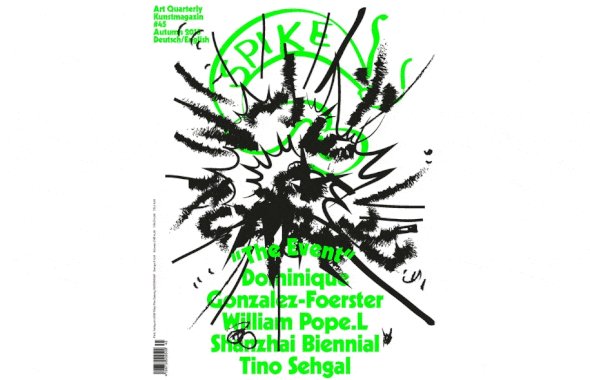spikeartmagazine.com
Get issue 45 or subscribe
Facebook / Instagram
9/11. The Greek referendum. Tonight’s opening. The many events that have nothing to do with spectacle or even remain invisible. The event holds the promise of the collective encounter; it is ubiquitous and rare. When does it begin: on Facebook, when you step through the door, or when the live-stream is running? Or perhaps only when something happens that can no longer be undone?
To find answers, we asked curators Vincent Honoré and Barbara Steiner, theorist Benjamin Noys, and artist Kenneth Goldsmith. We invited the curator of the 14th Istanbul Biennial Carolyn Christov-Bakargiev, artist Tino Sehgal, and the new director of the Münchner Kammerspiele Matthias Lilienthal to a roundtable discussion to talk about whether the aura of the art object is now attached to the event. Has everything become a performance? Is art becoming more like theatre? Is a new cultural form emerging that can change the structure of society?
We asked Bazon Brock to tell us about “The Hundred-Day Event,” Harald Szeemann’s unrealised original concept for his legendary documenta 5.
Does an event depend on human witnesses? No, writes theorist Benjamin H. Bratton in his essay “Without You,” in which he calls for a new, post-anthropocentric notion of the event.
The “Portrait” section features the New York-based artist collective Shanzhai Biennial, who use the strategy of the copy—or, better, a copy of the strategy—in a way that Harry Burke argues forces us to reconsider the relationship between art and image. Dominique Gonzalez-Foerster talks to Oliver Basciano about mixing up different times, meeting ghosts, and why she works against the theatre. Adrienne Edwards explores the American artist William Pope.L‘s targeted applications of pressure in exactly those places where race and capitalism meet in the American unconscious.
Anicka Yi tells us about some of her most admired artworks. Tim Griffin writes on a personal key work, Lou Reed’s The Drones. Theatre critic Jan Küveler celebrates the anarchic Regietheater, staged at Berlin’s legendary Volksbühne during Frank Castorf’s almost 25-year reign. Michele D’Aurizio discovers new techniques of dematerialization in fashion. Timo Feldhaus becomes addicted to the fascination of boredom in the latest instalment of Karl Ove Knausgaard’s My Struggle.
No art without alcohol: Spike celebrates the artist bar with Heimo Zobernig, Franz West, Flora Neuwirth, Hans Schabus, and Thomas Mießgang.
In our column “The End is Night,” artist Hannah Black tells of her recent trip to the sunken city of Atlantis, which she discovered was just another place where art has an essentially colonial position.
What of the summer’s exhibitions? Our restructured reviews section now presents surveys of the most important shows by cities and regions. Chris Sharp chose the highlights of Mexico City (including Marc Camille Chaimowicz and Gustav Metzger); in New York, Harry Burke liked a lot of what he saw but had some objections to Philippe Parreno‘s Park Armory. Alexander Scrimgeour saw Tino Sehgal, Laura Owens and Bill Lynch in Berlin. Andrew Berardini drove around Los Angeles, Max Henry checked out Cao Fei in his peregrinations around Vienna. João Laia visited the Serralves Museum’s Under the Clouds in Porto, and Kolja Reichert fell for Marlene Dumas in Basel.
Plus: image contributions by Slavs and Tatars, Nadine Fraczkowski/Anne Imhof, Oscar Murillo, Kim Gordon, and pcnc_bay with Riverside
We also hope you’ll be able to join us at the new fair Paris Internationale, where we are putting on a fantastic talks program (20–24 October).

